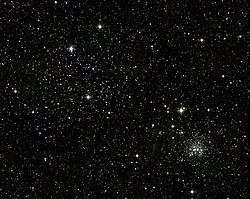Messier 35
| Messier 35 | |
|---|---|
|
| |
| Observation data (J2000 epoch) | |
| Constellation | Gemini |
| Right ascension | 06h 09.1m[1] |
| Declination | +24° 21′[1] |
| Distance | 2800 ly (850 pc) |
| Apparent magnitude (V) | 5.30 |
| Apparent dimensions (V) | 28 arcmins |
| Physical characteristics | |
| Radius | 11 ly[2] |
| Other designations | NGC 2168[1] |
Messier 35 (also known as M35, or NGC 2168) is an open cluster in the constellation Gemini. It was discovered by Philippe Loys de Chéseaux in 1745 and independently discovered by John Bevis before 1750. The cluster is scattered over an area of the sky almost the size of the full moon and is located 850 parsecs (2,800 light-years) from Earth.
The mass of M35 has been computed using a statistical technique based on proper motion velocities of its stars.[3] The mass within the central 3.75 parsecs was found to be between 1600 and 3200 solar masses (95 percent confidence), consistent with the mass of a realistic stellar population within the same radius.
The compact open cluster NGC 2158 lies directly southwest of M35.
See also
References
- 1 2 3 "SIMBAD Astronomical Database". Results for Messier 35. Retrieved 8 December 2006.
- ↑ Stoyan, Ronald; et al. (2008). Atlas of the Messier Objects. Cambridge University Press. p. 160. ISBN 9780521895545.
- ↑ Leonard, P. J. T.; Merritt, D. (1989). "The mass of the open star cluster M35 as derived from proper motions". Astrophysical Journal. 339 (1): 195–208. Bibcode:1989ApJ...339..195L. doi:10.1086/167287.
External links
- Messier 35, SEDS Messier pages
- M35 – Nightskyinfo.com
- Merrifield, Michael; Rothery, Roy. "M35 – Open Cluster". Deep Sky Videos. Brady Haran.
- Messier 35 on WikiSky: DSS2, SDSS, GALEX, IRAS, Hydrogen α, X-Ray, Astrophoto, Sky Map, Articles and images
Coordinates: ![]() 06h 09.1m 00s, 24° 21′ 00″
06h 09.1m 00s, 24° 21′ 00″

